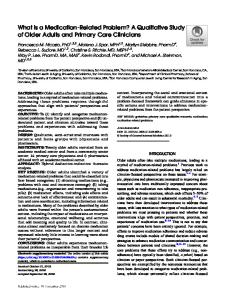What are the sources of distress in a range of cancer caregivers? A qualitative study
- PDF / 712,136 Bytes
- 11 Pages / 595.276 x 790.866 pts Page_size
- 33 Downloads / 289 Views
ORIGINAL ARTICLE
What are the sources of distress in a range of cancer caregivers? A qualitative study Jo Taylor 1,2,3
&
Elizabeth Fradgley 1,2,3,4
&
Tara Clinton-McHarg 2,3,5
&
Emma Byrnes 1,6
&
Christine Paul 1,2,3,7
Received: 5 May 2020 / Accepted: 4 September 2020 # Springer-Verlag GmbH Germany, part of Springer Nature 2020
Abstract Purpose Caring for a person diagnosed with cancer is associated with elevated distress that may impact on caregiver health and patient outcomes. However, caregivers’ distress is relatively under-researched. This Australian study explored a range of caregivers’ reported sources of distress. Methods The grounded theory approach informed semi-structured interviews that were conducted with a purposive and broad range sample of distressed caregivers identified through the ‘Structured Triage And Referral by Telephone’ (START) trial. A grounded theory framework was used to generate themes with data analysed by two independent coders using the NVivo software. Results Caregivers (n = 14) were aged from 25 to 80 years, including two bereaved caregivers. The relationships of the caregivers to the patients were as follows: partner (n = 8), parent (n = 1), child (n = 3), sibling (n = 1), and friend (n = 1). Six major themes emerged in relation to sources of distress: (1) a lack of sufficient and timely information; (2) uncertainty; (3) the role and duties of caregiving; (4) lack of family-centred services; (5) practical challenges; and (6) impact of distress. Conclusion Caregivers face a number of specific challenges beyond those experienced by patients. It is essential to ensure that caregivers are actively well-informed and well-supported alongside the person who is diagnosed with cancer. Keywords Cancer . Caregiver . Distress . Qualitative
Background Electronic supplementary material The online version of this article (https://doi.org/10.1007/s00520-020-05742-0) contains supplementary material, which is available to authorized users. * Jo Taylor [email protected] 1
School of Medicine and Public Health, University of Newcastle, Level 4 West, HMRI Building, Callaghan, NSW 2308, Australia
2
Priority Research Centre for Health Behaviour, University of Newcastle, Callaghan, Australia
3
Priority Research Centre for Cancer Research Innovation and Translation, University of Newcastle, Callaghan, Australia
4
Cancer Institute New South Wales, Eveleigh, Australia
5
School of Psychology, University of Newcastle, Callaghan, Australia
6
Priority Research Centre for Generational Health and Aging, University of Newcastle, Callaghan, Australia
7
Hunter Research Cancer Alliance, HMRI Building, New Lambton Heights, Australia
While there is no clear consensus on the definition of a caregiver [1], caregivers often routinely provide assistance and support of both a physical and a psychological nature, to a family member or friend with an illness or disability. A caregiver self-identifies and is usually also identified by the patient as playing an instrumental role in providing sup
Data Loading...











